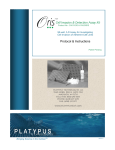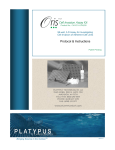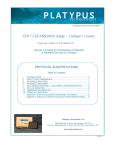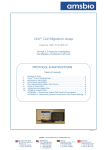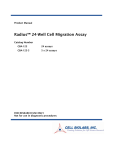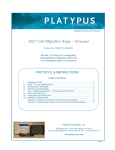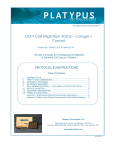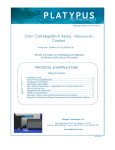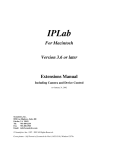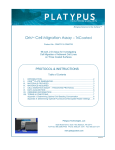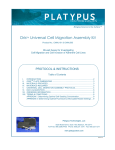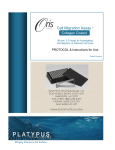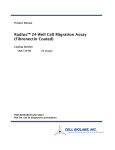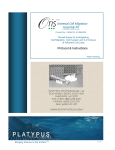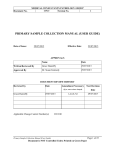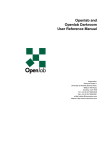Download OrisTM Cell Invasion & Detection Assay
Transcript
Bringing Science to the SurfaceTM OrisTM Cell Invasion & Detection Assay Product No.: CIA101DE & CIA200DE 96-well, 3-D Assay for Investigating Cell Invasion of Adherent Cell Lines PROTOCOL & INSTRUCTIONS I. II. III. IV. V. VI. VII. VIII. IX. INTRODUCTION ....................................................................................................................... 2 TM ORIS PLATE DIMENSIONS (per well) ................................................................................... 2 MATERIALS PROVIDED ........................................................................................................... 3 MATERIALS REQUIRED ........................................................................................................... 3 PRECAUTIONS AND RECOMMENDATIONS .......................................................................... 4 CELL INVASION & DETECTION ASSAY PROTOCOL ............................................................. 5 DATA ACQUISITION ................................................................................................................. 8 ORDERING INFORMATION.................................................................................................... 10 TERMS & CONDITIONS ......................................................................................................... 10 APPENDIX I: Determining Optimal Cell Seeding Concentration .............................................. 11 APPENDIX II: Determining Optimal Fluorescence Microplate Reader Settings ....................... 11 Platypus Technologies, LLC 5520 Nobel Drive, Suite 100, Madison, WI 53711 Toll Free: 866.3296.4455 Phone: 608.237.1270 Fax: 608.237.1271 www.platypustech.com RM0033.02 Oris™ CELL INVASION & DETECTION ASSAY I. INTRODUCTION The Oris™ Cell Invasion & Detection Assay is a reproducible, sensitive, and flexible assay that can be used to monitor cell invasion. Formatted for a 96-well plate, the assay utilizes Oris™ Cell Seeding Stoppers made from a medicalgrade silicone to restrict cell seeding to the outer annular regions of the wells. Removal of the stoppers reveals a 2 mm diameter unseeded region in the center of each well, i.e., the detection zone, into which the seeded cells may then invade. The Oris™ Detection Mask is applied to the plate bottom and restricts visualization to the detection zone, thus allowing only invading cells to be detected (see Figure 1). The Oris™ Cell Invasion & Detection Assay is designed to be used with any commercially available stain or labeling technique, but comes complete with a Calcein AM Staining Reagent. Calcein AM is a fluorescent dye that passes through the membrane of live cells and is useful for short-term labeling of cells at the end of the invasion period. Calcein AM is processed by esterases inside the cell allowing the dye to bind calcium and be trapped inside the cell, and has an excitation/emission wavelength of 495/515 nm. Readout can be performed by microscopy or use of a microplate reader. The Oris™ Cell Invasion & Detection Assay kit has been uniquely designed to detect cellular invasion in vitro within a 3dimensional extracellular matrix comprised of a basement membrane extract (BME) of the Murine Engelbreth-HolmSwarm tumor. The Oris™ Cell Invasion & Detection Assay system has been designed for use with adherent cell cultures. Performance of the Oris™ Cell Invasion & Detection Assay was optimized using the invasive HT-1080 fibrosarcoma and the non-invasive 3T3-Swiss albino fibroblast cell lines. Using the Oris™ Cell Invasion & Detection Assay offers the following features & benefits: • • • Membrane-free Invasion - perform studies without manipulating transmembrane inserts; no membrane to restrict the ability to image cells. Reproducible Results – obtain low well-to-well CV's due to the unique assay design. Preserve Cell Morphology – realize a more native 3-D invasion environment since cells are embedded in an extracellular matrix. Apply BME Coating & Populate Plates with Oris™ Cell Seeding Stoppers Seed & Adhere Cells onto Oris™ Plate • • Remove Stoppers to Create Detection Zone & Apply BME Overlay Figure 1. Schematic of Oris™ Cell Invasion & Detection Assay II. Versatile - analyze data using multiple probes in a single well by using a microscope, digital imager, or fluorescence microplate reader. Flexible - perform kinetic or endpoint cell invasion assays without the use of special instrumentation. Incubate and Allow Cells to Invade into Detection Zone Analyze Detection Zone (Cells that HAVE NOT Invaded into Detection Zone are Blocked from View with Detection Mask Attached) ORISTM PLATE DIMENSIONS (per well) Diameter of Well 6.5 mm Diameter of Stopper Space (Detection Zone) 2 mm Suggested Media Volume per Well (populated with Stoppers) 100 µl Effective Area of Outer Annular Region (seeding region) per Well 30.03 mm2 Effective Area of Central Detection Zone per Well 3.14 mm2 Important: Read Instructions Before Performing any OrisTM Assay. Platypus Technologies, LLC. RM0033.02 5520 Nobel Drive, Suite 100 Madison WI 53711 USA www.platypustech.com Toll Free: 866.296.4455 Phone: 608.237.1270 Fax: 608.237.1271 pg. 2 III. MATERIALS PROVIDED Product No.: CIA101DE Component Oris™ 96-well Plate Oris™ Cell Seeding Stoppers Oris™ Detection Mask Oris™ Stopper Tool Oris™ Basement Membrane Extract (BME) Stock Reagent Calcein AM Reagent Product No.: CIA200DE Component Oris™ 96-well Plates Oris™ Cell Seeding Stoppers Oris™ Detection Mask Oris™ Stopper Tool Oris™ Basement Membrane Extract (BME) Stock Reagent Calcein AM Reagent Quantity 1 96 1 1 Storage Room Temperature Room Temperature Room Temperature Room Temperature 5 mL < -20°C* 20 µL -20°C with dessicant** Quantity 2 2 x 96 2 2 Storage Room Temperature Room Temperature Room Temperature Room Temperature 2 x 5 mL < -20°C* 2 x 20 µL -20°C with dessicant** * Oris™ BME Stock Reagent can be stored at -20°C in a manual defrost freezer if kit will be used within 3 months of receipt. For long-term storage, maintain Oris™ BME Stock Reagent at -80°C. ** Calcein AM can be stored at -20°C in a manual defrost freezer with a dessicant for use within 6 months of receipt. IV. MATERIALS REQUIRED • • • • • • • • • • • Biological Cells Complete Cell Culture Growth Medium (containing serum) Sterile PBS (containing both Calcium and Magnesium) Hanks Balanced Salt Solution (HBSS) Serum-Free Cell Culture Medium Sterile Pipette Tips/Pipette or Multi-Channel Pipette Trypsin or Cell Scraper Inverted Microscope (optional) Fluorescence Microplate Reader (optional) Cell Culture Labeling Medium (phenol red-free/serum-free media) Cell Labeling Fluorescent Agent (e.g., CellTracker™ Green) - required if performing staining in addition to or in place of Calcein AM. Platypus Technologies, LLC. RM0033.02 5520 Nobel Drive, Suite 100 Madison WI 53711 USA www.platypustech.com Toll Free: 866.296.4455 Phone: 608.237.1270 Fax: 608.237.1271 pg. 3 V. PRECAUTIONS AND RECOMMENDATIONS For Research Use Only. Not for use in diagnostic procedures. Handling and Use of the Oris™ BME Stock Reagent: • Thaw on ice (2-8°C) overnight. • Please note that there will be lot-to-lot variations in the concentration of the Oris™ BME Stock Reagent. Refer to the BME concentration listed on the bottle label when preparing dilutions. It is crucial that the BME concentration be optimized for cell line and experimental conditions, since different cell lines and different experimental conditions can result in a range of cell invasiveness. • A suggested starting concentration for the Oris™ BME Stock Reagent is 10 – 12 mg/mL. However, do not dilute Oris™ BME Stock Reagent below 9 mg/mL, as this will preclude gel formation. • Aliquot and freeze any remaining Oris™ BME Stock Reagent. Avoid repeated freeze-thaw cycles. Recommendations for Preparation of Reference Wells: • To establish t=0 pre-invasion reference wells by seeding both test and reference wells at the same time, it is necessary to seed cells at different concentrations. Seed test wells at a density determined optimal in Appendix I, but seed reference wells at sub-optimal density (50-75% confluency). Allow cells to adhere and remove stoppers from test wells (overlay test wells with the Oris™ BME Stock Reagent and then incubate to allow for gel formation). Reference wells will remain populated with Oris™ Cell Seeding Stoppers until the end of the assay. At that point, remove the Oris™ Cell Seeding Stoppers from the reference wells, overlay the cells with the Oris™ BME Stock Reagent, and incubate to allow for gel formation. At this point, the entire plate can be stained and analyzed. • To establish t=0 pre-invasion reference wells by seeding test and reference wells at the same concentration, it is necessary to seed cells at different times during the assay. Seed test wells at density determined optimal in Appendix I, allow cells to adhere, remove stoppers, overlay with the Oris™ BME Stock Reagent, and incubate to allow for gel formation. Allow cells to invade for a set amount of time. At 4 - 18 hours prior to analyzing test wells, seed reference wells at a density determined optimal in Appendix I, and allow cells to adhere. At the end of the assay, remove stoppers from the reference wells, overlay them with the Oris™ BME Stock Reagent, and then incubate to allow for gel formation. At this point, the entire plate can be stained and analyzed. Oris™ is a trademark of Platypus Technologies, LLC. CellTracker™ Green is a trademark of Invitrogen Corporation. Platypus Technologies, LLC. RM0033.02 5520 Nobel Drive, Suite 100 Madison WI 53711 USA www.platypustech.com Toll Free: 866.296.4455 Phone: 608.237.1270 Fax: 608.237.1271 pg. 4 VI. CELL INVASION & DETECTION ASSAY PROTOCOL The following steps should be performed in a biological hood using aseptic technique to prevent contamination. 1. If desired, cells can be starved by incubating for 18 - 24 hours in serum-free medium prior to assay (0.5% fetal bovine serum may be used if needed). 2. Make 2 mL of a BME Coating Solution (final concentration of 3.5 mg/mL) by mixing thawed Oris™ BME Stock Reagent with cold Hanks Balanced Salt Solution (HBSS) or serum-free media. For example, if you have a 14 mg/mL Oris™ BME Stock Reagent, then mix 500 µL of the Oris BME Stock Reagent with 1.5 mL of HBSS or serum-free media. NOTE: BME gels in 5-10 min above 15°C; therefore, keep the BME Coating Solution on ice while coating all wells. The use of chilled pipette tips/reservoirs may be beneficial. Also, keep the remaining Oris™ BME Stock Reagent on ice until ready to use (Oris™ BME Stock Reagent will be used again in Step 17). 3. Pipette 100 µl of the BME Coating Solution into the wells of Column 1. Avoid bubble formation in the BME Coating by not fully expelling all contents of the pipette. Immediately remove the BME Coating Solution from the wells of Column 1 and return contents back into the BME Coating Solution reservoir. Repeat procedure for the remainder of plate. NOTE: The BME Coating Solution is only used in Step 3. 4. After the BME Coating Solution has been applied to all wells of the plate, check each well for excess solution. If excess solution is apparent, remove via pipette. 5. Incubate the plate in a humidified chamber (37°C, 5% CO2) for 15 - 30 minutes. 6. Under sterile conditions, populate the 96-well plate with Oris™ Cell Seeding Stoppers: • Vertically position the tip ends of two, 4-stopper strips into one full column of 8 wells at a time (Figure 2A). • Gently press down on the strip backbone to partially insert the stoppers halfway into the well (Figure 2B). • When both stopper strips have been partially inserted in 1 column, ensure that the position of the stoppers is vertical with respect to the well wall, making any necessary adjustments (Figure 2C). • Using the Oris™ Stopper Tool, firmly press down on the strip backbone to fully insert the stoppers into each well (Figure 2D and 2E). Repeat for all remaining columns. A) B) D) C) E) Figure 2. Stopper Insertion Process. A) Placement of Stoppers into Wells, B) Close-up of Stoppers Partially Inserted into Wells, C) Proper Placement of Stoppers, D) Pressing of Stoppers into Wells, and E) Fully Inserted Stoppers NOTE: It is extremely important to ensure that the stoppers are inserted perpendicular to the well bottom and are fully engaged with the bottom of the well. Failure to do so will increase the CV of your data set. 7. Visually inspect the underside of the populated 96-well plate to ensure that the Oris™ Cell Seeding Stoppers are firmly sealed against the bottom of the plate. To inspect the stoppers, turn the plate over and examine the stoppers for sealing (see Figure 3). If incomplete sealing is observed, return the plate to the upright position and use a sterile instrument to gently push the stopper back into the well until sealing is observed. A B C NOTE: The sealing of the stoppers can be most easily observed if the plate is tipped at an angle and viewed under indirect light to reveal the “bullseye” pattern at the bottom of each well. 8. Apply the Oris™ Detection Mask to the bottom of the 96-well plate if microplate reader data is being collected. The Detection Mask is not necessary if collecting imaging data. Platypus Technologies, LLC. RM0033.02 5520 Nobel Drive, Suite 100 Madison WI 53711 USA www.platypustech.com Figure 3. Stoppers that are: A) Partially Sealed B) Unsealed C) Completely Sealed Toll Free: 866.296.4455 Phone: 608.237.1270 Fax: 608.237.1271 pg. 5 VI. CELL INVASION & DETECTION ASSAY PROTOCOL, continued First Time Users: In order to prevent splashing of well contents, familiarize yourself with the attachment and removal of the Detection Mask before any liquids are placed into the wells: Aperture Orientation A-1 Corner Chamfer Attachment Lugs • Orient the chamfered corners of the mask with those of the 96-well plate, ensuring that the A1 corner of the mask is aligned with the A1 well of the plate (see Figure 4). • Align the holes in the attachment lugs with the bosses on the bottom of the plate. • Gently press the mask until it is flush with the bottom of the 96-well plate. NOTE: It may be necessary to wash the mask with ethanol to remove dust and debris since the mask is not sterile. The mask may be applied at any point during the assay. For kinetic assays, it is often most convenient to apply the mask at the beginning of the assay before any liquids are placed in the well. For endpoint assays, using fixed and stained cells, it is often most convenient to apply the mask just before reading assay results. 9. Figure 4. Features of Detection Mask If performing a kinetic analysis of cell invasion, pre-label cells with a fluorescent stain now. 10. Collect cells and prepare a suspension that is 10-fold greater in density than the optimal seeding concentration using complete cell culture growth medium containing serum. First Time Users: The optimum seeding density of cells must be determined as an integral part of the design of the cell invasion assay. Please refer to Appendix I for a discussion of this process. IMPORTANT: For recommendations on designating ‘reference’ wells, please refer to Section V: Precautions and Recommendations. Figure 5. Media is Added with Single or Multi-Channel Pipette 11. Pipette 100 µl of suspended cells into each test well through one of the side ports of the Oris™Cell Seeding Stopper. NOTE: For best results, add or extract media by placing the pipette tip along the wall of the well (see Figure 5). Care should be taken not to disturb the Oris™ Cell Seeding Stopper or the BME coating when introducing the pipette tip into the well. A slender/elongated tip or a gel loading tip may be useful. IMPORTANT: Lightly tap the plate on your work surface to evenly distribute well contents (extreme tapping may result in splashing of well contents and lead to contamination). 12. Incubate the seeded plate containing the Oris™ Cell Seeding Stoppers in a humidified chamber (37°C, 5% CO2) for 4 to 18 hours (cell line dependent) to permit cell attachment. A) B) C) 13. Remove plate from incubator. 14. Using the Oris™ Stopper Tool, remove stoppers (see Figure 6). NOTE: It may be necessary to wash the Oris™ Stopper Tool with 70% ethanol as the Stopper Tool is not sterile. D) E) • Secure the 96-well plate by holding it firmly against the deck of your work space. Slide the tines of the Oris™ Stopper Tool under the backbone of the stopper strip, keeping the underside of the Oris™ Stopper Tool flush with the top surface of the plate. • Lift the Oris™ Stopper Tool vertically to gently remove the stoppers. NOTE: DO NOT use the Oris™ Stopper Tool as a lever to pry the stoppers from the well (see Figure 6E), as doing so may cause displacement of seeded cells and may distort the detection zone area. Platypus Technologies, LLC. RM0033.02 5520 Nobel Drive, Suite 100 Madison WI 53711 USA www.platypustech.com Figure 6. Removal of Stoppers. Panels A, B, and C) Position the Tines of the Stopper Tool between the Stopper Tips, D) Lift Vertically, and E) Do NOT Pry Stoppers Toll Free: 866.296.4455 Phone: 608.237.1270 Fax: 608.237.1271 pg. 6 VI. CELL INVASION & DETECTION ASSAY PROTOCOL, continued 15. Remove media with a pipette and gently wash wells with 100 µl of sterile PBS (or serum-free media) to remove any unattached cells. Do not aspirate using an in-house vacuum. 16. Add 40 µl of the thawed Oris™ BME Stock Reagent to each well (supplements, such as FBS or growth factors, may be mixed with BME) to create a 3-D BME overlay. NOTE: Please note that there will be lot-to-lot variations in the concentration of the Oris™ BME Stock Reagent. Refer to the BME concentration listed on the bottle label when preparing dilutions. It is crucial that the BME concentration be optimized for cell line and experimental conditions, since different cell lines and different experimental conditions can result in a range of cell invasiveness. NOTE: BME gels in 5-10 min above 15°C, therefore, you must keep the thawed Oris™ BME Stock Reagent on ice until ready to use. In addition, the use of chilled pipette tips/reservoirs might be beneficial. 17. Incubate plate in a humidified chamber (37°C, 5% CO2) for 30 - 60 minutes to permit polymerization of the 3-D BME overlay. 18. Add 100 µl of serum-free cell culture medium on top of the 3-D BME overlay. Optional: Invasion inhibitors or stimulants may be added to the media. 19. Incubate plate in a humidified chamber (37°C, 5% CO2) to permit cell invasion (length of incubation is cell line dependent). The 3-D BME overlay will remain gelled for up to 14 days. Refresh media or supplements, every 48 - 72 hours, as needed, for the duration of the invasion experiment. 20. If performing an endpoint analysis of cell invasion, stain cells with a fluorescent stain after sufficient invasion has occurred. Refer to Section VI and Appendix II for further information on data acquisition and fluorescence staining technique. NOTE: Oris™ Cell Seeding Stoppers are for single use only; Platypus cannot guarantee the integrity of the stopper material after a second sterilization procedure. Platypus Technologies, LLC. RM0033.02 5520 Nobel Drive, Suite 100 Madison WI 53711 USA www.platypustech.com Toll Free: 866.296.4455 Phone: 608.237.1270 Fax: 608.237.1271 pg. 7 VII. DATA ACQUISITION The readout of the Oris™ Cell Invasion & Detection Assay can be conducted at any time, allowing the user to perform a kinetic assay or an endpoint assay. The Oris™ Cell Invasion & Detection Assay is designed to be used with any commercially available stain or labeling technique, but is supplied complete with the Calcein AM Reagent. The readout can be performed by using a microscope, a microplate reader, or a High Content Screening or High Content Imaging Analysis platform. Microscope Analysis • Cell counting or image capture / analysis software, such as NIH ImageJ freeware, can be used. • Note: Microscopic observations are possible using phase contrast or bright field microscopy with colorimetric stains. • No need to attach the Oris™ Detection Mask to the Oris™ microplate. • To set up reference controls, refer to Section V: Precautions and Recommendations. Microplate Reader Analysis • Attach the Oris™ Detection Mask to the bottom of the Oris™ microplate (see Step 8 of Protocol). • Optimal settings will vary according to the microplate reader make and model. Consult Appendix II and the equipment user manual for your particular instrument. • The microplate reader MUST be set to read from the bottom of the plate. • To set up reference controls, refer to Section V: Precautions and Recommendations. Sample Data Obtained via Microscopy and Microplate Reader are shown in Figure 7. 5 • Wells were seeded with 50,000 HT-1080 cells (i.e., 100 µl of 5x10 cells/mL) that had been serum starved for 18 hours and the plate was then incubated for 4 hours. The stoppers were removed from the wells and the OrisTM BME (final concentration of [12 mg/mL]) with 10% FBS or without FBS was overlayed on the cells (four (4) wells were left stoppered to represent t=0 reference). The plate was incubated in a humidified chamber for 48 hours to permit cell invasion. Cells were labeled with Calcein AM and images were captured using a Zeiss Axiovert microscope (5X magnification). Fluorescence in the detection zone was quantified by using a microplate reader. Each column represents the mean +/SD of at least 4 wells. A non-invasive cell line, 3T3-Swiss albino, served as the negative control. The images below, captured without a detection mask in place, illustrate representative data from pre-invasion (t=0 hrs) and post-invasion (t=48 hrs) wells. The graph depicts the average Relative Fluorescent Units (RFU’s) in the detection zones for each condition, confirming the invasion augmenting effect of FBS on serum starved HT-1080 cells and the lack of invasion by non-invasive 3T3-Swiss albino cells. • As observed in Figure 7, HT-1080 cells formed invadopodial structures that projected into the central detection zone (panel 1b) as compared to a time zero control (panel 1a). • Invasion by serum-starved HT-1080 cells was augmented by including 10% v/v fetal bovine serum (FBS) in the BME overlay (panel 1c). • In contrast, as observed in images 2b and 2c, the non-invasive 3T3-Swiss albino cells did not form any invadopodial structures and showed a nominal amount of FBS-independent migration into the central detection zone as compared to a time zero control (image 2a). Behavior of Invasive HT-1080 Cells in Oris 1a 1b TM Cell Invasion & Detection Assay 1c Measurement the OrisTM Detection ZoneDetection Using a Plate Reader Analysis of ofCells Cell in Invasion into the Oris™ Zone t=0 t=48h (no FBS) t=48h (10% FBS) Behavior of Non-Invasive 3T3-Swiss albino Cells in TM Oris Cell Invasion & Detection Assay 2a 2b 2c Invasive HT-1080 Cells t=0 t=48h (no FBS) Non-Invasive 3T3-Swiss albino Cells t=48h (10% FBS) Figure 7. Cell invasion data obtained via microscopy and microplate reader analysis Platypus Technologies, LLC. RM0033.02 5520 Nobel Drive, Suite 100 Madison WI 53711 USA www.platypustech.com Toll Free: 866.296.4455 Phone: 608.237.1270 Fax: 608.237.1271 pg. 8 Immunostaining Analysis • As verified by immunostaining (shown in Figure 8), the structures projecting into the BME formed by the invasive HT-1080 cells exhibited classic hallmarks of invadopodia, namely colocalization of F-actin with cortactin (panel a), and the expression of proteases such as MMP-9 and cathepsin B (panels b and c). These invadopodia could also be observed in 3-dimensions at different focal points along the z-axis. This is in contrast to any migratory activity observed by noninvasive cells that occurs only within the 2-dimensional space of the x and y axes (data not shown). TM Cell Invasion & Detection Assay were fixed, permeabilized, and pre-treated by sequential TM incubations in 3.7% formaldehyde, PBS, 0.5% Triton X-100, PBS, Image-iT FX signal enhancer, and PBS. Immunostaining was performed by incubating with primary antibodies (2 hours, 37°C) and Alexa Fluor® 488 conjugated secondary antibodies at 1:200 dilution (1 hour, 37°C) followed by an Alexa Fluor® 555 phalloidin counterstain (1 hour). Images were collected using a Nikon TE300 inverted microscope equipped with a Photometrics Coolsnap fx CCD camera, deconvolved using SlidebookTM v4.2 (Intelligent Imaging Innovations) and processed using Adobe® Photoshop® CS2 (Adobe Systems). • Cells from the Oris Anti-Cortactin a b F-actin is present in all eukaryotic cells, it is a major component of the cytoskeleton and functions to define and maintain the cell shape. Cortactin is a cellular protein that is present in and promotes the formation of lamellipodia and invadopodia. These structures propel cells over surfaces as they move toward a target. Results depicted in 8a demonstrate distinct areas of cortactin and F-actin colocalization characteristic of invadopodia (Ref. 1 & 2). Anti-Cathepsin B Cathepsin B is a lysosomal protease that facilitates cell invasion by degrading the surrounding extracellular matrix. Results depicted in 8b demonstrate distinct areas of lysosomal and peripheral cellular expression of Cathepsin B characteristic of protease expression observed in cancer cell invasion (Ref. 3). Anti-MMP-9 c MMP-9 is a protease that is involved in matrix degradation in cancer cell invasion. Results depicted in 8c demonstrate evidence of MMP-9 expression and secretion into surrounding areas of ECM, which are established characteristics of proteases observed at invadopodia sites (Ref. 1& 2). Figure 8. Confirmation of Cell Invasion using Immunostains References: 1. Weaver, AM; Clin Exp Metastasis 2006. "Invadopodia: specialized cell structures for cancer invasion." 23:97-105. 2. Furmaniak-Kazmierczak et al; Circulation Research 2007. "Formation of extracellular matrix-digesting invadopodia by primary aortic smooth muscle cells." 100:1328-1336. 3. Hulkower, KI et al; Eur. J. Biochem 2000. "Fluorescent microplate assay for cancer cell-associated cathepsin B." 267:4165-4170. Platypus Technologies, LLC. RM0033.02 5520 Nobel Drive, Suite 100 Madison WI 53711 USA www.platypustech.com Toll Free: 866.296.4455 Phone: 608.237.1270 Fax: 608.237.1271 pg. 9 VIII. ORDERING INFORMATION Product No. Product Description Package Size CIA101DE Oris™ Cell Invasion & Detection Assay, 1-pack: Oris™ 96-well plate, 1 TM Oris BME Stock Reagent, 5 mL Oris™ Cell Seeding Stoppers, 96 Oris™ Detection Mask, 1 & Oris™ Stopper Tool, 1 Calcein AM Reagent, 20 µL 1-pack CIA200DE Oris™ Cell Invasion & Detection Assay, 2-pack: Oris™ 96-well plates, 2 TM Oris BME Stock Reagent, 2 x 5 mL Oris™ Cell Seeding Stoppers, 2 x 96 Oris™ Detection Mask, 2 & Oris™ Stopper Tool, 2 Calcein AM Reagent, 2 x 20 µL 2-pack CMA1.101 Oris™ Cell Migration Assay, 1-pack: Oris™ 96-well, Tissue Culture Treated Plate (black, clear bottom) with Oris™ Cell Seeding Stoppers, 1 Oris™ Detection Mask, 1 & Oris™ Stopper Tool, 1 1-pack CMA5.101 Oris™ Cell Migration Assay, 5-pack: Oris™ 96-well, Tissue Culture Treated Plates (black, clear bottom) with Oris™ Cell Seeding Stoppers, 5 Oris™ Detection Mask, 1 & Oris™ Stopper Tool, 1 5-pack CMATR1.101 CMATR5.101 Oris™ Cell Migration Assay - TriCoated, 1-pack: Oris™ TriCoated, 96-well Plate with Oris™ Cell Seeding Stoppers, 1 32 wells, Uncoated, Tissue Culture Treated 32 wells, Collagen I coated 32 wells, Fibronectin coated Oris™ Detection Mask, 1 & Oris™ Stopper Tool, 1 Oris™ Cell Migration Assay - TriCoated, 5-pack: Oris™ TriCoated, 96-well Plates with Oris™ Cell Seeding Stoppers, 5 32 wells, Uncoated, Tissue Culture Treated 32 wells, Collagen I coated 32 wells, Fibronectin coated Oris™ Detection Mask, 1 & Oris™ Stopper Tool, 1 1-pack 5-pack To place an order, visit the Platypus Technologies website at: www.platypustech.com/order_main.html. For technical assistance, contact Technical Support at (866) 296-4455 or [email protected]. IX. TERMS & CONDITIONS Certain uses of these products may be covered by U.S. Pat. No. 6,284,197, No. 7018838, No. 10/597,118, No. 11/342,413, and No. 60/836,109, licensed to PLATYPUS. Certain applications of PLATYPUS products may require licenses from other parties. Determining the existence and scope of such third party intellectual property is the responsibility of the PURCHASER. Purchase of the product provides the PURCHASER with a limited non-transferable license under any PLATYPUS patents or patent applications to use the product for internal research unless there is a written limitation to this license in the product literature. PURCHASER is responsible for carefully reviewing the product literature and respecting any limitations to this license, e.g. limitations for commercial use or research by for-profit institutions. These products may not be resold, modified for resale, used to manufacture commercial products, or used to develop commercial products without the express written approval of PLATYPUS. These products are intended for research or laboratory use only and are not to be used for any other purposes, including, but not limited to, unauthorized commercial purposes, in vitro diagnostic purposes, ex vivo or in vivo therapeutic purposes, investigational use, in foods, drugs, devices or cosmetics of any kind, or for consumption by or use in connection with or administration or application to humans or animals. PLATYPUS warrants that its products shall conform substantially to the description of such goods as provided in product catalogues and literature accompanying the goods until their respective expiration dates or, if no expiration date is provided, for 6 months from the date of receipt of such goods. PLATYPUS will replace, free of charge, any product that does not conform to the specifications. This warranty limits PLATYPUS's liability only to the replacement of the nonconforming product. THIS WARRANTY IS EXCLUSIVE AND PLATYPUS MAKES NO OTHER WARRANTY, EXPRESS OR IMPLIED, INCLUDING WITHOUT LIMITATION, ANY IMPLIED WARRANTY OF MERCHANTABILITY OR FITNESS FOR A PARTICULAR PURPOSE. The stated express warranties, and the remedy provided for breach thereof, are in lieu of all other liability or obligations of PLATYPUS for any damages whatsoever arising out of or in connection with the delivery, use, misuse, performance, or the inability to use any of its products. IN NO EVENT SHALL PLATYPUS BE LIABLE UNDER ANY LEGAL THEORY (INCLUDING BUT NOT LIMITED TO CONTRACT, NEGLIGENCE, STRICT LIABILITY IN TORT, OR WARRANTY OF ANY KIND) FOR ANY INDIRECT, SPECIAL, INCIDENTAL, CONSEQUENTIAL, OR EXEMPLARY DAMAGES (INCLUDING BUT NOT LIMITED TO LOST PROFITS) EVEN IF PLATYPUS HAD NOTICE OF THE POSSIBILITY OF SUCH DAMAGES. Without limiting the effect of the preceding sentence, PLATYPUS's maximum liability, if any, shall not exceed the purchase price paid by PURCHASER for the product. This warranty shall not be effective if PLATYPUS determines, in its sole discretion that PURCHASER has altered or misused the goods or has failed to use or store them in accordance with instructions furnished by PLATYPUS. PLATYPUS’s sole and exclusive liability and PURCHASER’s exclusive remedy with respect to goods proved to PLATYPUS’s satisfaction (applying analytical methods reasonably selected by PLATYPUS) to be defective or nonconforming shall be the replacement of such goods free of charge, upon the return of such goods in accordance with our instructions, although at its discretion, PLATYPUS may provide a credit or refund. If PLATYPUS manufactures custom goods for PURCHASER based on instructions, specifications, or other directions provided by PURCHASER, PLATYPUS shall not be liable for the lack of sufficiency, fitness for purpose or quality of the goods to the extent attributable to such instructions, specifications, or other directions. PLATYPUS shall not be liable for any loss, damage or penalty as a result of any delay in or failure to manufacture, deliver or otherwise perform hereunder due to any cause beyond PLATYPUS’s reasonable control. PLATYPUS shall not be liable for injury or damages resulting from the use or misuse of any of its products. Platypus Technologies, LLC. RM0033.02 5520 Nobel Drive, Suite 100 Madison WI 53711 USA www.platypustech.com Toll Free: 866.296.4455 Phone: 608.237.1270 Fax: 608.237.1271 pg. 10 APPENDIX I: Determining Optimal Cell Seeding Concentration This procedure is intended to assist in determining the cell seeding density needed to achieve confluency of your cell line when using the Oris™ Cell Invasion & Detection Assay. The intended goal is to achieve 90-95% confluencey of the monolayer surrounding the Oris™ Cell Seeding Stoppers without overgrowth. 1. 2. 3. 4. A suggested starting point is to evaluate three serial dilutions at the cell densities shown below. The cell seeding area of the 2 well with the stopper in place is ~ 0.3 cm . Based on the typical seeding density of your particular cell line, you can infer a different cell number for your first serial dilution and adjust the numbers below accordingly. Prepare a log-phase culture of the cell line to be tested. Collect cells and determine the total number of cells present. 6 6 6 Pellet cells by centrifugation. Prepare three serial dilutions at final concentrations of 1.0 x 10 , 0.5 x 10 and 0.25 x 10 cells/mL. Dispense 100 µl of cell suspension per well into the 96-well plate to result in the following plate layout: Column Cells / well Number of wells 1 100,000 8 2 50,000 8 3 25,000 8 Incubate the plate in a humidified chamber (37°C, 5% CO2) for 4 - 18 hours (cell line dependent) with cell seeding stoppers in place to allow the cells to firmly attach to the well surface. 6. Following cell attachment, remove the Oris™ Cell Seeding Stoppers from each well (see Figure 6) and gently wash the wells with PBS to remove non-attached cells. • Secure the 96-well plate by holding it firmly against the deck of your work space. Slide the tines of the Oris™ Stopper Tool under the backbone of the stopper strip, keeping the underside of the tool flush with the top surface of the plate. • Lift the Oris™ Stopper Tool vertically to gently remove the stopper. Do not use the Oris™ Stopper Tool as a lever to pry the stoppers from the well as doing so may cause displacement of the seeded cells. 7. Without a Detection Mask in place, use a microscope to visually inspect each well to determine the minimum cell seeding concentration that yielded a confluent monolayer at the perimeter of the detection zone. At this point, if you plan to obtain the results of the Oris™ Cell Invasion & Detection Assay via colorimetric analysis or microscopy, you have successfully determined the optimal cell seeding concentration to be used in Step 11 of the Oris™ Cell Invasion & Detection Assay Protocol. 5. APPENDIX II: Determining Optimal Fluorescence Microplate Reader Settings This procedure is intended to assist in optimizing your instrument settings when using a fluorescence microplate reader to capture data from the Oris™ Cell Invasion & Detection Assay. 1. 2. Using the optimal cell seeding concentration determined in Appendix I, perform a cell invasion assay per Section VI, Oris™ Cell Invasion & Detection Assay Protocol using culture conditions expected to result in robust cell invasion. Be sure to include equal numbers of pre-invasion control wells (stoppers left in place until staining) and post-invasion test wells (stoppers removed after cell attachment period). A minimum of 8 wells per condition are recommended. Perform the desired fluorescent staining technique. The Oris™ Cell Invasion & Detection Assay has been designed to work with all types of fluorescent stains and staining techniques. The precise method for staining cells with fluorescent stains varies according to the nature of the individual stain. It is important to stain cells using a fluorescent reagent that uniformly stains cells. Probes affected by experimental conditions will increase variability of results and reduce correlation between fluorescence signal and cell invasion. Please consult the manufacturer of your fluorescent stain for specific considerations. The following is an example Fluorescent Staining Protocol for using Calcein AM: a. b. c. d. e. f. To stain one fully-seeded 96-well plate, combine 5 μl of Calcein AM (1 mg/mL in dry DMSO) with 10 mL of phenol redfree and serum-free media or 1x PBS. Protect diluted Calcein AM solution from light until ready to use in step d. Carefully remove culture medium from wells. Wash wells with 100 μl of PBS (containing both Calcium and Magnesium). Add 100 μl of diluted Calcein AM solution to each well. Incubate plate at 37°C for 30 - 60 minutes. Attach mask and read promptly with microplate reader using appropriate filter set and sensitivity/gain settings (for a BioTek Synergy™ HT microplate reader, use 485/528 nm excitation/emission filters, sensitivity 55 nm). 3. If not already in place, apply the Oris™ Detection Mask to the plate. Using the bottom probe of a fluorescence microplate reader, obtain the fluorescence reading from each well. To achieve the optimal dynamic range, adjust the instrument settings (e.g., gain) to result in the greatest difference in fluorescence signal between pre-invasion and post-invasion wells. Refer to the instrument manual for your microplate reader for further guidance on instrument settings. You have now successfully determined the optimal cell seeding concentration (to be used in Step 11 of the Oris™ Cell Invasion & Detection Assay Protocol) and microplate reader settings for analysis of cell invasion using a fluorescence microplate reader. Platypus Technologies, LLC. RM0033.02 5520 Nobel Drive, Suite 100 Madison WI 53711 USA www.platypustech.com Toll Free: 866.296.4455 Phone: 608.237.1270 Fax: 608.237.1271 pg. 11











